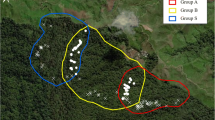Abstract
We investigated the mechanism of alliance formation among adult male savanna baboons by comparing the characteristics of males that formed coalitions frequently with males that never or seldom took part in coalitions. We observed three groups: two of Papio cynocephalus cynocephalusin Amboseli National Park, Kenya, and one of P. c. anubisin the vicinity of Gilgil, Kenya. We considered four hypotheses: (1) Males must be familiar with each other, (2) males must have an affinitive bond, (3) males must have more than average experience, and (4) the combined fighting ability of the coalition partners relative to the fighting ability of their opponent determines the likelihood that a coalition is formed. We conclude that relative fighting ability forms the key factor in coalition formation. High- ranking males do not form coalitions often, since they hardly need them. Low- ranking males rarefy form coalitions, since they cannot form effective coalitions among themselves. Affinity (“friendship”) may play a role as an additional factor. The relation of coalition formation with age and period of residence, which was found in several studies, can be explained largely by the correlation between these parameters and fighting ability.
Similar content being viewed by others
References
Altmann, J. (1974). Observational study of behavior: sampling methods.Behaviour 49: 227–267.
Altmann, J. (1980).Baboon Mothers and Infants, Harvard University Press, Cambridge, MA.
Altmann, J., Altmann, S. A., and Hausfater, G. (1981). Physical maturation and age estimates of yellow baboons,Papio cynocephalus, in Amboseli National Park, Kenya.Am. J. Primatol. 1: 389–399.
Altmann, J., Hausfater, G., and Altmann, S. A. (1985). Demography of Amboseli baboons, 1963–1983.Am. J. Primatol. 8: 113–125.
Altmann, J., Hausfater, G., and Altmann, S. A. (1988). Determinants of reproductive success in savannah baboons,Papio cynocephalus. In Clutton-Brock, T. H. (ed.),Reproductive Success. Studies of Individual Variation in Contrasting Breeding Systems, University of Chicago Press, Chicago, pp. 403–418.
Bercovitch, F. B. (1986). Male rank and reproductive activity in savanna baboons.Int. J. Primatol. 7: 533–550.
Bercovitch, F. B. (1988). Coalitions, cooperation, and reproductive tactics among adult male baboons.Anim. Behav. 36: 1198–1209.
Collins, D. A. (1981).Social Behaviour and Patterns of Mating Among Adult Yellow Baboons (Papio c. cynocephalusL. 1766), Thesis, University of Edinburgh, University Microfilms International, Ann Arbor, MI.
Colmenares, F. (1990). Greeting behaviour in male baboons. I. Communication, reciprocity and symmetry.Behaviour 113: 81–116.
Colmenares, F. (1991). Greeting behaviour between male baboons: oestrous females, rivalry and negotiation.Anim. Behav. 41: 49–60.
de Vries, H. (1993). The rowwise correlation between two proximity matrices and the partial rowwise correlation.Psychometrika 58: 53–69.
de Waal, F. B. M. (1987). Dynamics of social relationships. In Smuts, B. B., Cheney, D. L., Seyfarth, R. M., Wrangham, R. W., and Struhsaker, T. T. (eds.),Primate Societies, University of Chicago Press, Chicago, pp. 421–429.
de Waal, F. B. M., and Luttrell, L. (1988). Mechanisms of social reciprocity in three primate species: Symmetrical relationship characteristics or cognition?Ethol. Sociobiol 9: 101–118.
Hamilton, W. J., III, and Bulger, J. B. (1990). Natal male baboon rank rises and successful challenges to resident alpha males.Behav. Ecol. Sociobiol. 26: 357–362.
Hausfater, G. (1975).Dominance and Reproduction in Baboons, Contributions to Primatology Series, Karger, Basel.
Hemelrijk, C. K. (1990a). Models of, and tests for, reciprocity, unidirectionality and other social interaction patterns at group level.Anim. Behav. 39: 1013–1029.
Hemelrijk, C. K. (1990b). A matrix partial correlation test used in investigations of reciprocity and other social interaction patterns at group level.J. Theor. Biol. 143: 405–420.
Kawai, M. (1958). On the system of social ranks in a natural group of Japanese monkeys. I. Basic rank and dependent rank.Primates 1: 111–130. [(English translation in Imanishi, K., and Altmann, S. A. (eds.) (1965)Japanese Monkeys, Emory University, Atlanta, pp. 66–86.]
Manzolillo, D. L. (1982).Intertroop Transfer by Adult Male Papio anubis, Thesis, University of California, Los Angeles.
Noë, R. (1986). Lasting alliances among adult male savannah baboons. In Else, J. G., and Lee, P. C. (eds.),Primate Ontogeny, Cognition and Social Behaviour, Cambridge University Press, Cambridge, pp. 381–392.
Noë, R. (1989).Coalition Formation Among Male Baboons, Thesis, University of Utrecht, Utrecht.
Noë, R. (1990). A Veto game played by baboons: a challenge to the use of the Prisoner’s Dilemma as a paradigm for reciprocity and cooperation.Anim. Behav. 39: 78–90.
Noë, R. (1992). Alliance formation among male baboons: shopping for profitable partners. In Harcourt, A. H., and Waal, F. B. M. de (eds.),Coalitions and Alliances in Humans and Other Animals, Oxford University Press, Oxford, pp. 285–321.
Noë, R. (1994). A model of coalition formation among male baboons with fighting ability as the crucial parameter.Anim. Behav. 47:211–213.
Noë, R., and Sluijter, A. A. (1990)., Reproductive tactics of male savanna baboons.Behaviour 113: 117–170.
Packer, C. (1979). Male dominance and reproductive activity inPapio anubis.Anim. Behav. 27: 37–45.
Ransom, T. W. (1981).Beach Troop of the Gombe, Bucknell University Press, Lewisburg, Penn.
Rasmussen, K. L. R. (1980).Consort Behavior and Mate Selection in Yellow Baboons (Papio cynocephalus), Thesis, University of Cambridge, Cambridge.
Siegel, S., and Castellan, N. J., Jr. (1988).Nonparametric Statistics for the Behavioral Sciences, 2nd ed., McGraw-Hill, New York.
Smuts, B. B. (1985).Sex and Friendships in Baboons, Aldine, Hawthorne, New York.
Smuts, B. B. (1987). Sexual competition and mate choice. In Smuts, B. B., Cheney, D. L., Seyfarth, R. M., Wrangham, R. W., and Struhsaker, T. T. (eds.),Primate Societies, University of Chicago Press, Chicago, pp. 385–399.
Smuts, B. B., and Watanabe, J. M. (1990). Social relationships and ritualized greetings in adult male baboons(Papio cynocephalus anubis).Int. J. Primatol. 11: 147–172.
Sokal, R. R., and Rohlf, F. J. (1981).Biometry, 2nd ed., Freeman, San Francisco.
Strum, S. C. (1982). Agonistic dominance in male baboons: An alternative view.Int. J. Primatol. 3: 175–202.
Author information
Authors and Affiliations
Rights and permissions
About this article
Cite this article
Noë, R., Sluijter, A.A. Which adult male savanna baboons form coalitions?. International Journal of Primatology 16, 77–105 (1995). https://doi.org/10.1007/BF02700154
Received:
Revised:
Accepted:
Published:
Issue Date:
DOI: https://doi.org/10.1007/BF02700154




